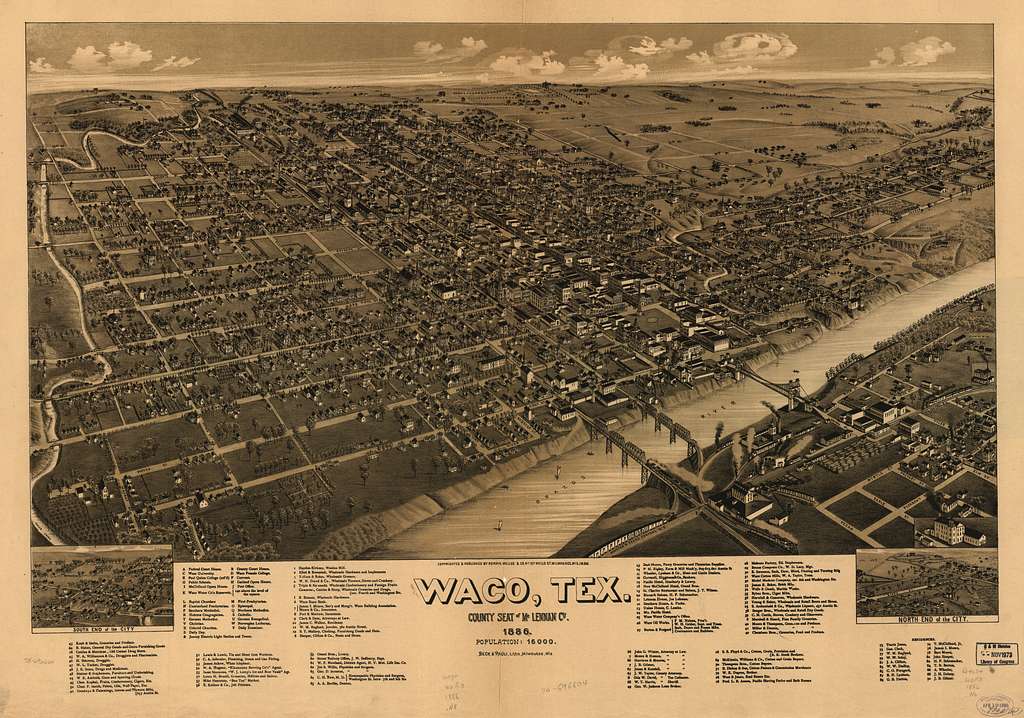In the mid-19th century, as settlers pushed westward across the American frontier, Texas stood as a wild and untamed land of opportunity and danger. Through the eyes of one family’s experiences, we can glimpse the extraordinary challenges and remarkable resilience that defined life in early Texas. This account, passed down through generations, offers a vivid portrait of a time when Native American tribes still roamed freely, buffalo herds thundered across the plains, and the first seeds of civilization were taking root in what would become the Lone Star State.
The Ross Family: Pioneers of Waco
Our story centers on the Ross family, particularly Captain Shapley P. Ross, a true Texas pioneer who settled near Waco Spring in 1849. As his descendant recounts:
“My grandfather was Captain Shapley P. Ross. In 1849 he built a cabin on the bank of the Brazos river near Waco Spring.”
This simple act of building a cabin marked the beginning of a new era for the region. The Ross family would become integral to the growth of Waco and witnesses to the dramatic changes that swept across Texas in the following decades.
Encounters with the Comanche
Life on the frontier was fraught with danger, and perhaps no threat loomed larger than that posed by Native American tribes, particularly the Comanche. The Ross family’s encounters with the Comanche illustrate the complex and often tense relationships between settlers and indigenous peoples.
One particularly harrowing incident occurred around 1850 when Captain Ross was bedridden with measles:
“My grandfather was in bed with the measles about the year 1850, as well as I recall, when one day a band of Comanche Indians was seen coming to the house. My grandfather told my grandmother that the Indians would probably kill him and take her and the two little boys captive, and if they did, for her to take a cloth with her and tear pieces of it off and drop them as they went along, and the settlers would find them and possibly find her.”
This tense moment highlights the ever-present fear of attack that settlers lived with. However, the outcome of this encounter was unexpected:
“The chief came to the door and started in, but when he saw grandfather lying there in bed with the measles broken out on his face the Indian was afraid of him, and did not come in. He told grandmother that they wanted beef and watermelons, and to send the boys to show than where the beef and melons were.”
This incident reveals the complex interplay of fear, superstition, and pragmatism that often characterized interactions between settlers and Native Americans. The Comanche’s fear of disease likely saved the Ross family from a far worse fate.
Interestingly, this was not the end of the story. Years later, at the Dallas Fair, Captain Ross had a surprising reunion:
“About twenty-five years later grandfather was at the Dallas Fair, and saw a band of Indians which were there on exhibition. When he came to them, one of them spoke to him and told him that he remembered him as the sick man, that it was his band which had come to grandfather’s house that day.”
This encounter underscores how the paths of settlers and Native Americans continued to cross in unexpected ways as Texas developed.
The Legend of Bigfoot
Captain Ross’s reputation grew through his interactions with the Comanche, none more famous than his confrontation with a renowned chief known as Bigfoot:
“In the early Fifties my grandfather killed a Comanche Chief known as Bigfoot, who was one of the greatest chiefs of that tribe and the most powerful one at the time of his death.”
This event, recorded in Wilbarger’s “Indian Depredations in Texas,” became the stuff of frontier legend. It also led to another remarkable encounter:
“About two years after the fight one evening when Plaoedore, a former chief of the Tonkawa tribe, and who was a faithful friend of grandfathers, was sitting on the front porch, a Comanche came to the house and said he wished to see Captain Ross.”
This Comanche, claiming to be Bigfoot’s brother, sought to live with Captain Ross out of respect for his prowess. The story that follows, involving a gruesome act of self-mutilation to prove loyalty, vividly illustrates the stark cultural differences and the complex honor codes that governed interactions on the frontier.
The Growth of Waco
As the Ross family put down roots, they witnessed and contributed to the growth of Waco from a scattered settlement to a proper town. The family claims some notable “firsts” in the area’s history:
“My mother, Kate Ross, was supposed to be the first white girl born in Waco. It’s thought that my uncle, Robert S. Ross, was the first white child born in McLennan county.”
These milestones mark the transition of the area from wilderness to settled territory. The account also provides a vivid image of Waco in its early days:
“I remember my mother telling me that when she was a little girl, in the early 1850s, great herds of buffalo would came to Waco, which was then only a village of scattered houses among fields of corn and other crops.”
The description of the entire town mobilizing to divert buffalo herds away from their crops paints a vivid picture of the challenges faced by early settlers:
“When the buffalo were seen coming the alarm would be given by shouting ‘Here come the buffalo,’ and ringing a bell. Then all the people would stop what they were doing and go north of the town in their wagons and make a line of the wagons around the town.”
This communal effort to protect their livelihoods from nature’s forces exemplifies the spirit of cooperation that was essential for survival on the frontier.
The Changing Face of Texas
As Texas grew and developed, new signs of progress appeared. The arrival of steamboats on the Brazos River marked a significant step forward in transportation and commerce:
“There was a flat-bottomed steamboat called the ‘Katie Rose’ after my mother, which ran up and down the Brazos from Waco carrying supplies to settlements along the river. This was about 1860.”
This development would have significantly improved the flow of goods and people, helping to knit the scattered settlements of Texas into a more cohesive whole.
The account also offers glimpses of how entertainment and social life evolved in these frontier towns. The description of traveling foot racers in the 1870s provides an interesting snapshot of frontier recreation:
“Along during the 1870s men who were fleet of foot would go from settlement to settlement and challenge anybody to a footrace, and those racers and the people of the settlements would bet on the races.”
The story of “Deerfoot” and his defeat by a local Waco man not only entertains but also illustrates the pride that frontier towns took in their local champions.
Even more intriguing is the account of an early attempt at record-breaking:
“In 1875 there was a man who wanted to make a record for the shortest time carrying mail twenty miles by riding around the racetrack. He wore out the horse he started with, then he used all his horses one after another, and then the people got so interested in seeing him make a record that they took horses from their wagons and buggies and also let him have their saddle horses to ride so he could break the record.”
This event, combining the practical concern of mail delivery with the thrill of record-breaking, shows how frontier communities could come together in pursuit of a common goal, even if that goal was simply excitement and local pride.
Conclusion: The Legacy of Texas Pioneers
The Ross family’s account provides us with a remarkable window into the lives of Texas pioneers. From harrowing encounters with Native Americans to the gradual taming of the wilderness, we see the determination, resourcefulness, and courage that it took to build a life on the frontier.
These stories remind us that the history of Texas is not just a tale of grand political movements or famous battles. It’s also the story of ordinary families facing extraordinary challenges. The Ross family’s experiences – building the first cabin in Waco, diverting buffalo herds, witnessing the arrival of steamboats, and participating in the social life of a growing town – all contribute to the rich tapestry of Texas history.
As we reflect on these accounts, we gain a deeper appreciation for the complex relationships between settlers and Native Americans, the daily struggles of frontier life, and the gradual transformation of Texas from a wild frontier to a settled territory. The legacy of pioneers like the Ross family lives on in the vibrant communities they helped to establish and in the enduring spirit of independence and resilience that characterizes Texas to this day.
Their stories serve as a vivid reminder of how far Texas has come in a relatively short span of time, and they challenge us to consider how we might honor and build upon the legacy of these early pioneers. As we face our own challenges in the modern era, we would do well to remember the grit, community spirit, and adaptability that defined those who came before us and shaped the Texas we know today.


